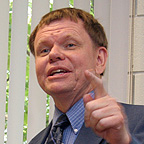The Day of Pentecost, Cycle B (2015)
THEME OF THE DAY: The Holy Spirit Gets Around.
Sermons on the Holy Spirit and the Church are especially appropriate, but the Sunday’s Trinitarian perspective entails that Creation and the Spirit’s Work in the Church and in that Christian life (Sanctification) are also relevant themes.
Psalm 104:24-34,35b
This is a hymn to God the Creator, with praise for His Providential interventions. It has similarities to the Egyptian Hymn to Aten. The verses considered focus in praise on the multiplicity of creatures that God has created (vv.24-25). God is said to have subdued all the things of the sea, including the monster of chaos, Leviathan (vv.25-26; cf. 79:12-17). This reference to subduing the sea may relate to the Priestly version of Creation in Genesis, which refers to the watery chaos which God is said to have overcame in creating us (Genesis 1:9-10). Providence and the creating role of the Sprit [ruach, also translated “wind”] are stressed in the Psalm (v.30; God as the One Who gives food and other good things with the Spirit and Who also takes away life [vv.27-29]). All living things depend on Him. These themes could also be related to the ecological agenda or to justice. The Lesson concludes with praise of God’s awesomeness (vv.32ff.).
Application: As in the year past on Pentecost Sunday, this Psalm affords several sermon possibilities. Sermons on Creation, Providence, the unity of all living things in the midst of their diversity are legitimate directions. Care for creation and human unity also legitimately emerge as themes (Social Ethics) as well as the Spirit of God’s life-giving and sustaining role – a construal of the Trinity most suggestive of Pentecost and its Word of the Spirit giving life.
Acts 2:1-21
We could not begin the Pentecost Season without a report of the first Pentecost from the second half of a two-part history of the Church traditionally attributed to Luke, a physician and Gentile associate of Paul (Colossians 4:14; II Timothy 4:11; Philemon 24). We note again that there is some dispute about the date of composition, whether it was composed before Paul’s Martyrdom (in 65-67 AD) or much later, after the destruction of The Jerusalem Temple in 70 AD. In any case the author’s stress on the universal mission of the Church (1:8) and so an effort to validate Paul’s ministry reflects in this Lesson. The attention given by the Book to recounting of the gift of the Holy Spirit to the faithful (and the origin of the Church) at Pentecost is hardly surprising given the author’s concern to stress the Work of the Holy Spirit ([Brevard Childs, The New Testament as Canon: An Introduction, p.221).
Jewish tradition held that the Law was given on the day that Christians commemorate as Pentecost, fifty days after Passover (Leviticus 23:15-21). Luke often says that all faithful were together in order to underscore unity of the community (2:44; 4:24; 5:12). This theme is emphasized in this Lesson. The gift of the Holy Spirit [pneuma hagion] (baptism of the Holy Spirit) had been promised by John the Baptist (Luke 3:16). Reference to the Spirit’s appearance as of tongues [glossa] of fire (v.3) is reminiscent of references to the tongues/flames [lahab] of fire issued by Old Testament writers to suggest God’s Presence (Isaiah 66:15-16; 5:24; cf. Exodus 19:18). Luke reports that John the Baptist had promised a Baptism of the Holy Spirit and fire [pur] (Luke 3: 16; also see Jesus’ Promise in Luke 24:49). The report of speaking in other languages [dialektos] and the ability to understand each other (vv.4-11) is a reversal of The Tower of Babel (Genesis 11:1-9) and another mark of the unity of the community. This experience of actually understanding foreign language may be different from the Pentecostal experiences reported by Paul about the Corinthian church which seems to have manifested not in foreign languages but ecstatic, incoherent forms of speech [glossa] (I Corinthians 14:1-33). But the skepticism of some who observed the event, accusing those who had the experience of the Spirit of being drunk [full of new wine] (v.13), is a reference suggestive of the Pentecostal experience noted in I Corinthians 12:13. And the fact that the Greek term glossa (as in glossolalia) is also used in this account suggests that the first Pentecost also seems to have been an ecstatic experience.
Peter is reported to stand to defend the validity of the experience that those filled with the Spirit are not drunk (vv.14-16). His sermon, based on Joel 2:28-32, follows (vv.17-21). It teaches that the pouring out of the Spirit on all (even on slaves and women, vv.18) is a mark of the Messianic Age. The sermon based on the Joel text underlines the eschatological nature of the text. Peter then proclaims Justification By Faith (v.21).
Application: The text continues to invite sermons on the Church (its multi-cultural unity which counteracts how The Tower of Babel experience has divided us) and its implications for how the faitful live in harmony (Sanctification) on the Holy Spirit (as a sign of the End Times in which we live [Realized Eschatology]), or about charismatic/pentecostal experience (see the discussion, above of the different kinds of manifestations of tongues in the New Testament).
or
Ezekiel 37:1–14
Ezekiel was a Prophet from a priestly family whose ministry to his fellow Exiles during the Babylonian Captivity extended from 593 BC to 563 BC. Some of the oracles pre-date Jerusalem’s fall. The original collection was rewritten and expanded by an editor. The Book includes judgment of Judah for its idolatry and defilement of the sanctuary, the proclamation of God’s abiding Presence among the people, consolation and hope expressed in a proclamation of God’s unconditional care.
This text recounts the famed vision of the reviving of the dry bones. These bones [etsem] represent the Exiles and the hopes of Israel’s resuscitation (vv.11-13). Ezekiel’s response to whether the bones can come back to life bespeaks an affirmation of God’s power (v.3). The Word of the Lord is the means of giving new life (v.4). References to the “breath” to be put in the bones (vv.5,9-10) use the same Hebrew word ruach as is translated “the Lord’s Spirit” (v.14), bringing the bones to life. The Spirit of God gives life. Note that the Hebraic holistic view of persons, not a Greek view of the immortal soul, operates here. The Hebrews will return to the land (v.14). A continuity is posited with the Old Covenant, as reference is made to obedience to the Law/statutes [chuqqah] even after the resuscitation of the people (v.24). The resurrection of Israel is a testimony to God’s act in history.
Application: Sermons on this text can proclaim a fresh start from stagnation or oppression (Justification By Grace and Realized Eschatology). The Spirit’s role in this liberation should be stressed.
Romans 8:22-27
This authentically Pauline Epistle was probably written between 54 AD and 58 AD. It is a letter of introduction to a church which Paul had not previously visited, a church which may have been comprised of largely Jewish Christians. This may explain his focus on the different (grace-oriented vision) of the role of the Law in the Christian life.
In this Lesson Paul continues a discussion of the impact of God’s saving act in view of the continuing realities of sin. Nature is thought of as sharing the stress, anxiety, and pain which we ourselves feel as we await redemption. The text proclaims the hope of fulfillment. The faithful and the whole of creation [ktisis] groans [sustenazo] in labor pains. The metaphor of birth pains was used by other early Christian writers to describe the eschatological transition from one era to another (cf. Mark 13:8). Paul notes that, possessing the Spirit’s first fruits, we groan inwardly, but wait for fulfillment (vv.22-23). Reference is made to the hope [elpis] in which we are saved [sozo]. He is not seen; we must wait with patience (vv.24-25). The Spirit [pneuma] helps in our weakness, Paul adds. We do not know how to pray, but the Spirit intercedes [entugchano] (vv.26-27).
Application: This text will inspire sermons which call attention to our sinful condition (how it impacts the whole created order) along with the Good News that the Holy Spirit ushers in a new era, helping us in our weakness and interceding for us (Justification, Sanctification, and Realized Eschatology).
or Acts 2:1–21
See the first option for the First Lesson.
John 15:26-27; 16:4b-15
Again we note that this Book is the last of the four Gospels to be written, probably not composed until the last two decades of the first century. It is very different in style in comparison to the other three (so-called Synoptic) Gospels. In fact it is probably based on these earlier Gospels. The Book has been identified with John the Son of Zebedee, the Disciple whom Jesus loved, and this claim was made as long ago as late in the first century by the famed theologian of the early Church Irenaeus (Ante-Nicene Fathers, Vol.1, p.414). It is likely that it was written by a disciple of John. Hints of that possibility are offered by the first post-Biblical Church Historian Eusebius of Caesarea who claimed that the Book was written on the basis of the external facts made plain in the Gospel, and so John is a “spiritual Gospel” (presumably one not based on eye-witness accounts of the author) (Nicene and Post-Nicene Fathers, Second Series, Vol.1, p.261). More recently, as we have observed, scholars have rediscovered the assessment of another early writer of the Church, Papias, who claimed that John was an eyewitness. This has led such scholars to suggest that this Gospel may have been eyewitness testimony after all ( Richard Bauckham, Jesus and the Eyewitnesses, pp.423ff.; cf. Ante-Nicene Fathers, Vol.1, pp.154-155). Its main agenda was probably to encourage Jewish Christians in conflict with the synagogue to believe that Jesus is the Messiah, the Son of God (20:31; cf. 16:2).
The Lesson is a continuation of Jesus’ Farewell Discourse. It begins with Jesus claiming that He will send the Advocate (parakletos, helper or defense lawyer), the Spirit of truth [pneuma tace aletheias] Who proceeds [ekporeuomai] from the Father (15:26). Jesus claims to reveal new things to His Disciples not previously taught because He was with them. But now He is returning to the One Who sent Him (16:4b-5). Despite sorrow that might emerge as a result of His departure, Jesus notes it is to His followers’ advantage, since then the Advocate will be sent (16:6-7). The Spirit will prove the world wrong about [convict the world of] sin and about righteousness [dikaiosune] and judgment [krisis], for the ruler of the world has been condemned (16:8-11). The Greek term used for world in v.8 is kosmos, which can refer to present human reality.
Jesus proclaims that He has more to say, but His followers cannot bear it now (16:12). Yet the Spirit will guide them into truth and, speaking not on His own, will declare what is to come (16:13). The Spirit will glorify [doxa] Christ, taking what is Christ’s and declare it (16:14). All that the Father has, Jesus claims, is His; this is why the Spirit takes what is His and declares it to the faithful (16:15). Jesus concludes by noting that in a little while He will not be seen [theoreo], but then again a little while longer and He will be seen (16:16). This seems to be an eschatological comment, pointing to Jesus’ ongoing Presence after His Resurrection and eschatological Return.
Application: Sermons on this text can proclaim the gifts of the Holy Spirit, how He reveals new insights (Eschatology), convicts Sin, advocates for the faithful, and gives the faithful all that God has (Justification By Grace). References to the relation of Spirit, Father, and Son open the way to reflections on the Trinity.

























